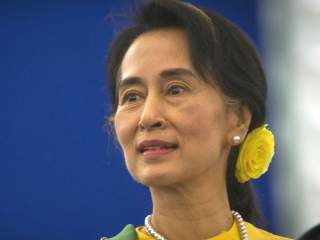Genocide and Democracy in Burma
Azeem Ibrahim and Richard Cockett plot Myanmar's uncertain trajectory.
Small wonder that so many of the Rohingyas have chosen to flee to more hospitable climes, often in ramshackle boats that have left thousands dead. All this has been so exhaustively covered by now that I confess to being somewhat mystified by Ibrahim’s subtitle: surely the atrocities committed against the Rohingya are by now in full view of the international community. Even so, his exhaustively researched book does a valuable job of recording the group’s suffering in painful detail, and he is right to urge the world to pay even closer attention to what is happening in Arakan. Burmese officials don’t seem to share the concern. In 2009, one Burmese diplomat in Hong Kong publicly described the Rohingyas as “ugly as ogres,” people whose skin was not as “fair and soft” as that of other minority groups. I can only assume, based on my own interviews, that such views are entrenched among many members of the Buddhist elite. I have even encountered them, rather dispiritingly, among the leaders of the prodemocracy movement.
The most incendiary anti-Rohingya rhetoric has come with the rise of the Buddhist nationalist organization Ma Ba Tha, which was founded just two years ago. Despite the suddenness of the group’s appearance, its well-funded and strikingly well-organized activists almost immediately succeeded in marshaling tens of thousands to their cause and prevailed upon the government to pass a series of discriminatory laws for the “protection of race and religion”—one of which gives officials the power to disallow marriages between people of different faiths. Needless to say, the “race and religion” these laws are supposed to safeguard are that of the Buddhist majority—quite a few of whom genuinely appear to believe that their coreligionists, who make up some 90 percent of the population, face an existential threat from the Muslim minority, closer to 5 percent.
When I interviewed a leading monk and Ma Ba Tha founder named U Pamaukka, he put it like this: “The Muslims are starting to consume our people.” He was worried, he explained, that Burma could go the way of Indonesia. Buddhism had flourished there too, he said, until the thirteenth century—but today the country is 87 percent Muslim. “The Arabs came to Indonesia,” he told me. “They noticed that Buddhist people are very kindhearted and soft.” And so, he concluded, they were wiped out.
STILL, THERE is good reason to question the spontaneity of the recent surge of anti-Rohingya sentiment, even as the government was preparing for the country’s first free election in decades. As Ibrahim notes, “This situation is no accident; it has been deliberately manufactured.” The generals, keen to retain their influence over the liberalization process, needed a way of maintaining pressure on Aung San Suu Kyi—and the Rohingya, as Cockett puts it, offered them the perfect wedge issue. If she came to the beleaguered minority’s defense, she could be accused of betraying her coreligionists. If she declined to take the Rohingyas’ side, liberal activists and human-rights organizations would be compelled to denounce her.
In the end, she decided to hedge her bets, speaking vaguely of the need for “rule of law” without mentioning the Rohingya or their travails by name. She was correspondingly criticized by many of her former allies. In the November election, Ma Ba Tha activists dropped their nonpartisan pretense and called upon good Burmese Buddhists to cast their votes for the ruling party, the vehicle of the generals and their cronies.
Yet the Burmese electorate didn’t respond the way Ma Ba Tha had anticipated. Rank-and-file Burmese ended up giving just about every vote they could to Suu Kyi’s NLD—just under 80 percent of the vote. In other words, for the overwhelming majority of the electorate, putting Aung San Suu Kyi into power and striking a blow against the old regime trumped sectarian demagoguery. Ibrahim has done his homework, but he seems to have overlooked this part of the equation, writing at one point that the NLD’s “electoral support comes almost entirely from the ethnically Burmese community.”
On election day, the NLD won huge majorities even in the states on the ethnic periphery, belying Ibrahim’s reductionism. As I interviewed voters in Rangoon, I was struck by how many of the city’s Muslims appeared perfectly happy to vote for the NLD, which they regarded as a much better guarantor of their rights than the party of the old regime. (And this even though the NLD rather ominously declined to run even a single Muslim candidate in the election.)
This is not to say that all is well with democracy in Burma; yet it is also surely too much to declare as Ibrahim does that the country’s democratic opening ought to be dismissed as a myth. There is an important political reality to keep in mind here: a government that can count on legitimacy genuinely grounded in popular approval, in stark contrast to its bankrupt predecessor, ought to be in a far better position to make positive changes in the lives of the Rohingya. There are plenty of reasons, as both Ibrahim and Cockett remind us, to be skeptical about Burma’s democratic future. But you never know. Its new leaders might just surprise us.
Christian Caryl is a senior fellow at the Legatum Institute and a contributing editor at Foreign Policy.
Image: Wikimedia Commons/Claude TRUONG-NGOC.

